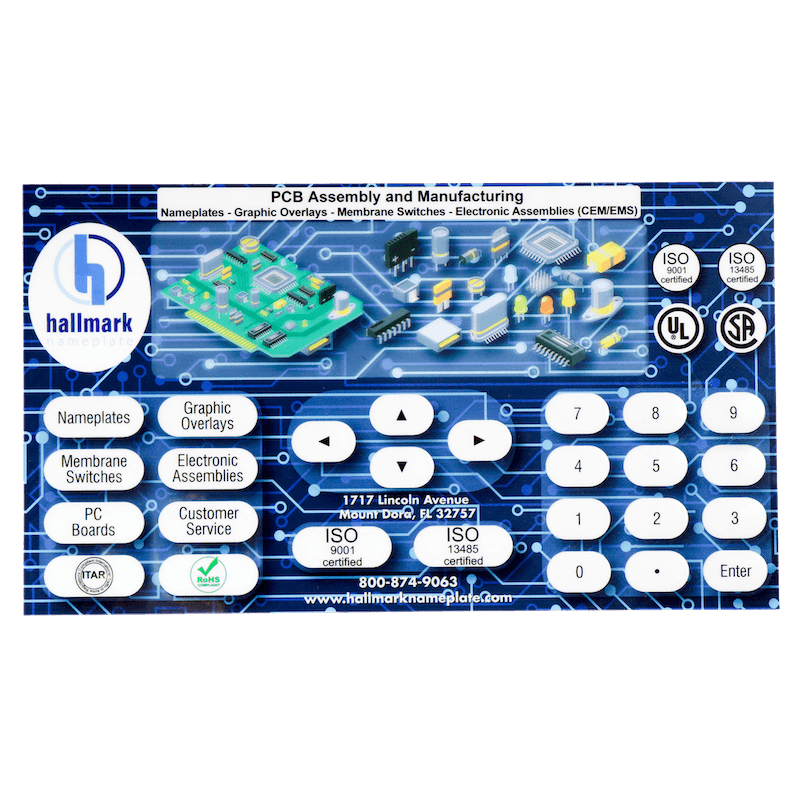Membrane Switch: A Comprehensive Guide to Its Uses and Applications
Membrane Switch: A Comprehensive Guide to Its Uses and Applications
Blog Article
Recognizing Membrane Layer Changes: The Secret to Durable and Trusted Controls

What Are Membrane Buttons?
Membrane layer buttons are an advanced solution in the realm of individual interface modern technology, incorporating functionality and layout flawlessly. These gadgets work as a user interface between users and electronic systems, integrating a number of components right into a compact layout. Commonly constructed from versatile, thin layers of products, membrane layer switches are developed to react to touch, enabling individuals to engage with machinery and digital gadgets properly.
The primary aspects of a membrane switch consist of a published circuit layer, visuals overlay, and a spacer layer that stops unintended activation. The visuals overlay can be personalized to reflect brand name identification or customer choices, enhancing aesthetic appeals while ensuring functionality. Membrane switches are typically utilized in numerous applications, including clinical devices, consumer electronic devices, and industrial devices, owing to their sturdiness and resistance to ecological aspects such as dampness and dust.
One of the key benefits of membrane layer buttons is their capability to withstand deterioration, making them perfect for high-traffic environments. Furthermore, they are light-weight and need marginal room, permitting cutting-edge designs in product growth. Generally, membrane changes stand for a functional and efficient option for modern-day electronic user interfaces, marrying technology with user-centric layout principles.
How Membrane Layer Changes Work
The procedure of membrane layer switches hinges on a simple yet effective system that converts individual input right into digital signals. When a customer presses the button, the leading layer warps, permitting a conductive aspect in the circuit layer to make call with a corresponding conductive pad on the bottom of the graphic overlay.
The design of membrane buttons can differ, yet they commonly integrate domes or responsive aspects to supply comments to the customer, boosting the overall experience - membrane switch. The products used in membrane layer switches, such as polyester or polycarbonate, add to their durability and resistance to ecological elements, consisting of moisture and dirt. The printed circuits are normally enveloped, which shields them from wear and tear over time.
Benefits of Membrane Switches

Furthermore, membrane buttons are known for their sturdiness. Constructed from durable materials, they are resistant to dirt, moisture, and physical wear, which significantly expands their lifespan contrasted to traditional mechanical buttons. This durability makes them especially appropriate for high-traffic environments and applications requiring durability.
One more significant advantage is the ease of cleaning and upkeep. The smooth surface area of membrane changes reduces dirt buildup and is usually impervious to spills, making them optimal for setups that need frequent sanitization.
Moreover, membrane layer buttons provide a structured account, leading to a thinner layout that can be integrated into various tools without including bulk. This feature not just enhances the aesthetic appeal yet likewise adds to an extra ergonomic item layout.
Applications of Membrane Layer Switches
User-friendly and versatile, membrane layer buttons discover applications across a variety of sectors, including clinical gadgets, customer electronics, and industrial devices. In the clinical area, these buttons are essential to devices such as analysis equipment, patient monitoring systems, and mixture pumps, where reliability and this page simplicity of cleansing are vital. Their capability to hold up against harsh environments and maintain performance makes them optimal for such applications.

In customer electronic devices, membrane layer switches are utilized in products like microwaves, washing devices, and remotes - membrane switch. Their sleek design permits intuitive user interfaces, improving the overall customer experience while offering toughness and resistance to tear and put on
Commercial equipment additionally gains from membrane buttons, specifically in control panels for equipment and automation systems. These buttons use protection against dirt and dampness, guaranteeing consistent performance in tough atmospheres. Furthermore, their personalized functions permit suppliers to tailor them to specific go functional requirements, improving performance and capability.
Picking the Right Membrane Switch
When picking a membrane layer switch, it is necessary to think about various aspects that influence performance and suitability for certain applications. The primary considerations include ecological problems, tactile comments, sturdiness, and layout specifications.
First, analyze the operating environment; switches revealed to dampness, chemicals, or severe temperatures require details materials to guarantee long life and capability. Next, review the demand for tactile feedback. Depending upon individual interaction, some applications might gain from a responsive response to verify activation, while others may prefer a non-tactile layout for visual factors.
Toughness is an additional important factor; membrane switches must be created to stand up to regular use, effects, and abrasion. Ensure the chosen button can withstand the anticipated lifecycle, specifically in high-usage scenarios.

Final Thought
In verdict, membrane layer switches offer as necessary elements in the design of resilient and reputable control systems across various markets. The versatility of membrane layer changes enables for tailored remedies that fulfill details operational requirements, reinforcing their importance in modern-day innovation.
Membrane check my site layer switches over represent a vital aspect of modern interface layout, mixing functionality with resilience in various applications.Membrane buttons are a sophisticated service in the world of individual interface technology, combining functionality and design perfectly. Generally built from adaptable, thin layers of products, membrane switches are created to respond to touch, enabling users to engage with machinery and electronic gadgets effectively.
The layout of membrane buttons can differ, however they typically include domes or tactile components to supply feedback to the customer, improving the general experience.In conclusion, membrane layer switches over offer as vital components in the design of reputable and long lasting control systems throughout various industries.
Report this page